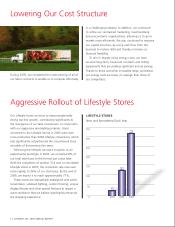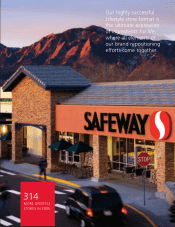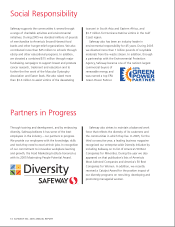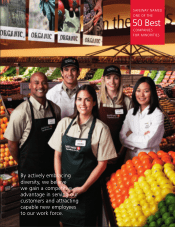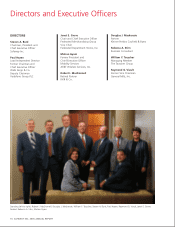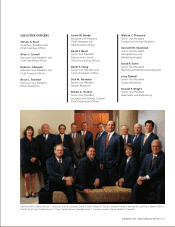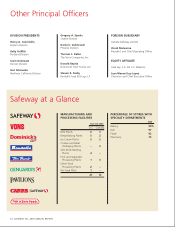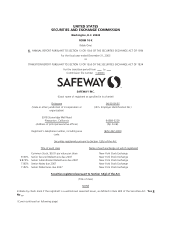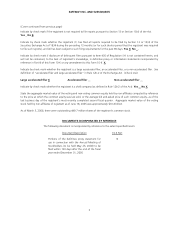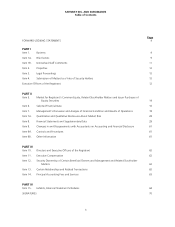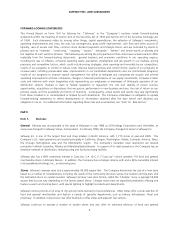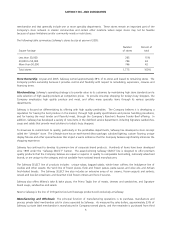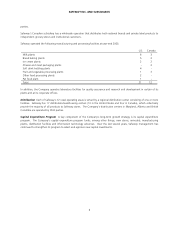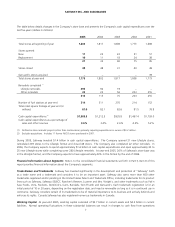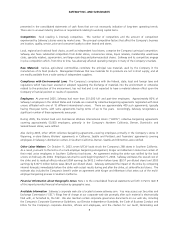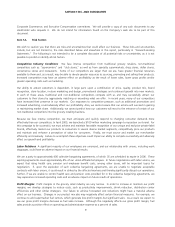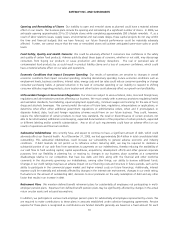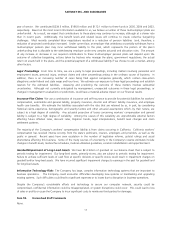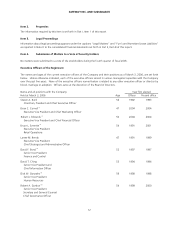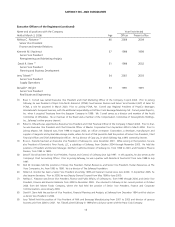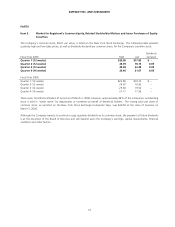Safeway 2005 Annual Report Download - page 24
Download and view the complete annual report
Please find page 24 of the 2005 Safeway annual report below. You can navigate through the pages in the report by either clicking on the pages listed below, or by using the keyword search tool below to find specific information within the annual report.SAFEWAY INC. AND SUBSIDIARIES
4
FORWARD-LOOKING STATEMENTS
This Annual Report on Form 10-K for Safeway Inc. (“Safeway” or the “Company”) contains certain forward-looking
statements within the meaning of Section 27A of the Securities Act of 1933 and Section 21E of the Securities Exchange Act
of 1934. Such statements relate to, among other things, capital expenditures, the valuation of Safeway’s investments,
operating improvements and costs, tax rate, tax contingencies, gross profit improvement, cash flow and other sources of
liquidity, uses of excess cash flow, common stock dividend payments and Lifestyle stores, and are indicated by words or
phrases such as “estimate,” “continuing,” “ongoing,” “expect,” “anticipate,” “believe” and similar words or phrases and
the negative of such words or phrases. The following are among the principal factors that could cause actual results to differ
materially from the forward-looking statements: general business and economic conditions in our operating regions,
including the rate of inflation, consumer spending levels, population, employment and job growth in our markets; pricing
pressures and competitive factors, which could include pricing strategies, store openings and remodels by our competitors;
results of our programs to control or reduce costs, improve buying practices and control shrink; results of our programs to
increase sales, including private-label sales, improvements in our perishables departments and our promotional programs;
results of our programs to improve capital management; the ability to integrate any companies we acquire and achieve
operating improvements at those companies; changes in financial performance of our equity investments; increases in labor
costs and relations with union bargaining units representing our employees or employees of third-party operators of our
distribution centers; changes in state or federal legislation or regulation; the cost and stability of power sources;
opportunities, acquisitions or dispositions that we pursue; performance in new business ventures; the rate of return on our
pension assets; and the availability and terms of financing. Consequently, actual events and results may vary significantly
from those included in or contemplated or implied by such statements. The Company undertakes no obligation to update
forward-looking statements to reflect developments or information obtained after the date hereof and disclaims any
obligation to do so. For additional information regarding these risks and uncertainties, see “Item 1A. Risk Factors.”
PART I
Item 1. Business
General Safeway was incorporated in the state of Delaware in July 1986 as SSI Holdings Corporation and, thereafter, its
name was changed to Safeway Stores, Incorporated. In February 1990, the Company changed its name to Safeway Inc.
Safeway Inc. is one of the largest food and drug retailers in North America, with 1,775 stores at year-end 2005. The
Company’s U.S. retail operations are located principally in California, Oregon, Washington, Alaska, Colorado, Arizona, Texas,
the Chicago metropolitan area and the Mid-Atlantic region. The Company’s Canadian retail operations are located
principally in British Columbia, Alberta and Manitoba/Saskatchewan. In support of its retail operations, the Company has an
extensive network of distribution, manufacturing and food processing facilities.
Safeway also has a 49% ownership interest in Casa Ley, S.A. de C.V. (“Casa Ley”) which operates 119 food and general
merchandise stores in Western Mexico. In addition, the Company has a strategic alliance with and a 56% ownership interest
in GroceryWorks Holdings, Inc., an Internet grocer.
Stores Safeway's average store size is approximately 45,000 square feet. The Company determines the size of a new store
based on a number of considerations, including the needs of the community the store serves, the location and site plan, and
the estimated return on capital invested. Safeway's primary new store format, called the “Lifestyle” store, is typically 55,000
square feet but can vary depending on the factors stated above. Lifestyle stores have an expanded perishables offering and
feature a warm and inviting décor, with special lighting to highlight products and departments.
Safeway’s stores provide a full array of dry grocery items tailored to local preferences. Most stores offer a wide selection of
food and general merchandise and feature a variety of specialty departments such as bakery, delicatessen, floral and
pharmacy. In addition, many stores now offer Starbucks coffee shops and adjacent fuel centers.
Safeway continues to operate a number of smaller stores that also offer an extensive selection of food and general


